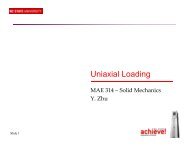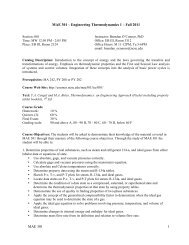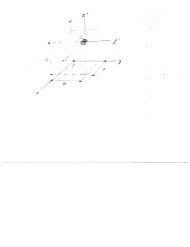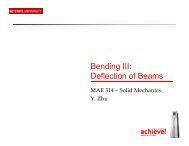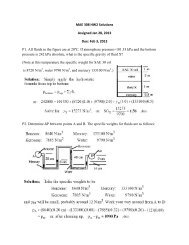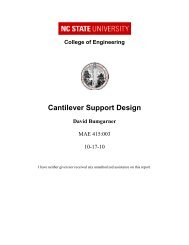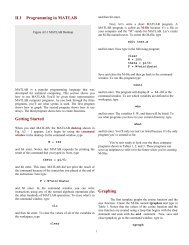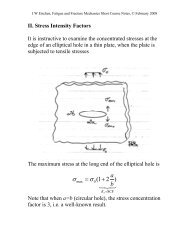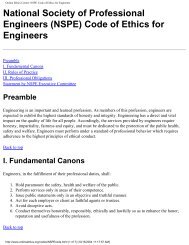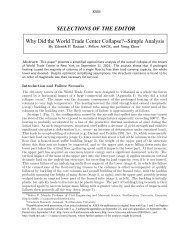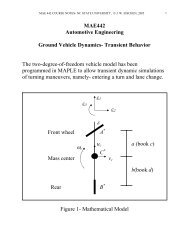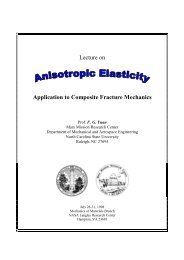Create successful ePaper yourself
Turn your PDF publications into a flip-book with our unique Google optimized e-Paper software.
'., :'-""t"~""IIU:t:'I". 1 ,..:!!;;:.":, ,, ,., ""O ""o..t."",...,..", .,' "J"':::;;;""""'~'"",,;:,,:;;,,;:;o::::;:;;:;;:::;"::;::;;;:;:;:a-li::;..;:H!;:'::: I.." t .'" ',"rj""" ""',n""'. ""'",~..::-:!!"r;::: ..:f,:'?=:iFF.H;i"'r:':w:,: ,::, .:~:;; ';"':;::::: ;.,on.,,::, ,:::: .~H";',::1;:;
tlOnSlllpwas used to approximate the nonlinear bending stiffness in fabrics, The ~dvantageof this method is that the fabric nonlinear bending behavior, which is inherentin most fabrics, can be well represented; this property may not always be obtainfrom the traditional cantilever beam test.'1~~~" ~~t!:~.~~Understanding the bending behavior offabrics is animportant topic in scientific textile research as well asin industrial appJications, Fabric bending behavior hasbeen the focus of many investigations, Most studieseither concern theoretical modeling of the fabric bendingproperties or actual measurement using variousmethods.Peirce first introduced a linear model of bendingbehavior of fabrics in the 1930s [9]; this is probablythe most simple and useful model that is still widelyapplied in many textile areas, By using a first-orderapproximation, this model is based on the assumptionthat the bending rigidity is independent of the curvature,Most fabrics display a nonlinear moment-curvaturerelationship during bending. Strictly speaking,the linear bending behavior model usually cannot satisfactorilydescribe the fabric bending process. To addressthis inadequacy, several nonlinear bending modelshave been proposed in the literature. They includeGrosberg's frictional couple theory [5]. which we laterdeveloped by adding the effect of fabric weight [2); thebilinear bending theory was proposed and developedsuccessively by Huang [6], Leaf[8), and Ghosh [3],These nonlinear bending models can more closely describethe actual moment-curvature relations of fabrics,and thus are preferable whenever a theoretical inves-@ Tex,ile Resean:h InstilU..tigation of fabricbehaviorin the bendng or buckling- -processes becomes necessary, -There are a variety of methods or sta dards of measuringwoven fabric bending rigidity.T 0 of these havebeen widely adopted by scientific h institutionsand textile industries: the ASTM met od 01388 [I](the cantilever beam test) and the wabata purebending test [7J,In the ASTM method, a critical .. ding length"of a beam is measured when the secant I ne across bothpoints of the beam's fixed and fteeends akes an angleof 41,50 to the horizontal. The bendin ~ rigidity B ofthe beam is defined asB = W({r 'where w is the fabric weight per unit are and L is thebending length, This method was devel ped based onthe linear beam theory [10], Actually, most fabricspossess a strong nonJinear bending be vior, as de.scribed by Grosberg [4). This method i only capableof providing an average value of the be ding rigidityof the fabric, an obvious shortcoming.The Kawabata bending tester is desig to directlymeasure the fabric moment-curvature r lationship inpure bending. By subjecting a fabric mple to a(I)'.S2sfi1'9?I II,I1- ._-~.~
dSEPTEMBER 1990527)=1nghe:orle-,tolet'usies.yn, is.nym-lay2)3)ataledchlasate,f alessIon'ateics,,J1iIj ~~~Thus the angle of the tangent at the point i. 0,. iscomputed as(: 0,=I- tan-I )/x-x,/=I,2.,...N-l , (4)At the end point N, a fixed end boundary condition isimposed so that ON= ,,{2. With this formulation.weobtained a series of polar coordinate data pairs (s,. 0,).2, Calculal/on of the moments M,: In a cantileverbeam test, the internal bending moment at a cross sectionlocated at an arbitrary point s is caused by thefabric's own weight. Analytically, it can be expressedas [10]M = i' ws'sinOds' ,At the conclusion of step 3, we C~puted the M-K(5) coordinates (K" M,) for one fabric mple, The M-Kdata can then be used to approxim te the nonlineart>.M,= w sin 0, ".' s'ds'L "where. - !:.s'= WSIOO, s'+'-2 !:.s,(- 'where w is the fabric weight per unit area and s' is a bending stiffness.dummy variable.For our discretization scheme, the internal moment Approximation of Bendin.at a point / + I, M,+,, can be written asBending stiffness B(K) is defined the change inM,+,= i"" ws' sin Ods'moment divided by the change in c rvature or dM{dK. Since most fabrics display nonli ear bending behavior,bending stiffness is a function of curvature.= Nonlinear bending stiffness can 0 ten be approximatedusing a bilinear fit [3, 6, 8], I bilinear theory,1" ws' sin Ods' + "" ws' sin Ods'D L ", the moment versus curvature relatio ship is continu-= M, + t>.M, , I = I, 2, . . . , N - I ,( 6 ) ous, but the bending stiffness versus urvature is diswheret>.M,is the differential increment of moment continuous. Bending stiffness,althou nonlinear, is abetween point / and / + I, M, = 0, and t>.M,can be continuous function of curvature in t e fabrics. In thisapproximated asstudy, we adopted a similar considerat on in the methodologyfor computing B(K) using in rectJy measuredM-K data. But we used a method of uadratic-linearfit to guarantee the continuity of mom nt and bendingstiffness over the full range ofmeasu curvatures.For practical considerations. when t e bending stiffnessof a specific fabric needs to be qu ntified, at least)/ = I, 2. . , ..N - I . (7) several representative samples should measured. The( 0,+1+0, )sin(O,)=slO ~ .3. Calculal/on of the curvatures K, = dO;/ds: To obtainthe local curvature K, = dO;/ds,weagainusedthemethod of least squares fifth-order polynomial regressionto simulate the relation of 0 = F(s).In this study, the inclining angle 0 isa monotonicallyincreasing and slow varying function of the arc lengths. We found from computational practice that therewas little difference using third-, founh-, or fifth-orderpolynomials to simulate the relationship of 0 = F(s).We selected a fifth-order to reduce he complexity ofthe computer program, since we h d already incorporatedthis regression analysis sub utine in the program.The purpose of this regressionpr ure is to smooththe data and to avoid possible large numerical errors,which may be produced either by u 'ng the finite differencemethod or the second-order derivatives whenthe values of curvature K are to be enerated. By differentiatingthe regression function (s), the local curvaturesK, are obtained fromK _dF I N'-d ,1-1, , .Is ""1average moment-curvature relations ip from thosesamples should characterize fabric. M ment-curvaturedata are computed from several fabric mples. A leastsquares regression method is used to 0 tain the "meanvalue" of the M-K curve. For all meas red data, a quadraticregression and a linear regressio are taken. Thesecond-order polynomial is merely a st-fit approximationbased on the shape of ex rimental M-Kcurves. This model more closely simul tes the bendingstiffness as a continuous function ofth curvature thana discontinuous, bilinear fit. The resul nt M-K curvecan be written as'-'(8)M, = a, +b,K+c,K' (9)
528TEXTILERESE,1RCH JOURNALandAl, = G, + b,K ,where G, and G, are not necessarily equal to zero.The value of B obtained by differentiating Equation9 will be used for small values of K. Values of B in thisrange may be termed the "initial bending stiffness."Obviously, B now is a linear function of the curvatureK. The value of B obtained by differentiating Equation10 is to be used for large values of K, the result beingcalled the "ultimate bending stiffness." Equations 9and 10 are not the final forms of M-K curve to beconstructed in this study. The moment-curvature relationshipof a fabric should meet the conditions ofcausality (M = 0 for K = 0), continuity, and uniqueness.To build an M-K curve to satisfy these requirements,we use the following method.Considering the fact that B is a continuous functionfor all values of K, the followingcondition ofcontinuitymust be satisfied:dM, - dM,dK-dKSolving Equation II yieldsKo= b, - b, .2c,at K=Ko .Integrating the functions of dM, I dK and dMd dK,using the conditions of M = 0 for K = 0 and MI = M2at K = Ko, the new M-K curve is given byandM,=b,K+c,K2, IKI:;;Ko ,M2 = Mo + b2K , IKI > Ko ,( 10)(II)(12)( 13)where Mo = (b, - b2)Ko + c,Ko2.Our regression method computes a continuous M-K curve that is more representative of a real fabricmoment-curvature relationship than a bilinear curve.the free end, s= 51L.O < s < I. Thesy bol",denotes,,'LJthe weight factor. where IV= B' F r a cantileverbeam, the boundary conditions are dO/ s = 0 at s = 0and 0 = 0 at s = I. When the value of IVis known, aunique solution of 0 at the free end can found usinga numerical integration method. Thus [ e fabric bendingcurve expressed as the x-)" coordin tes is also determined.In this study, we used the fifth order Runge-Kutta method to solve the initial valu problem inEquation 14; the implementation ofthi method ap..pears in an earlier paper [2J. Note that n the processof numerical evaluation, the normalized urvature (K)is always equal to the normalized mome t M, since- dO fi --,' d -' - 5)K = di = Jo ws SID0 5 =. (IWe solved Equation 14 for a givenval e of IV,andalso calculated 2I x- y coordinates along t e deformedfabricsamplefroms=Otos=I(.l.f= .05),alongwith the value of dOld.f(equivalent to K nd M). Onthe other hand, our program uses the 0 tained displacementdata, in x-y pairs, and the v ue of w asinput to calculate the values of Kand ii. e can thencompare the values of K and M calculatedusingth=two methods for validation.Two typical values of W, 10 and 40. we e taken inthe numerical evaluation. Using the R nge-Kuttamethod and solving Equation 14, the va ues of thenormalized curvature at the fixed end (s = I) were3.746for w= 10and 8.459for Ii'= 40, ctively.The numerical resultsof usingthese tw programsare shown in Figure 2 for w = 10and Fig re 3 for w=40. For w= 10,we limited the accuracy 0 the input. %0.005. %0.0005- eXietNumerical VerificationWe wrote a Fortran computer program based on thealgorithm described above. In order to validate !he algorithm,we used a typical example of linear bendingto check the performance of the program.The nondimensional equation governing an elasticain large deformation may be written as [2Jd20 = wssinOds2(14)where s is the normalized length variable starting fromi,KFIGURE2. Comparison of the theorehcaJ predicti"n.and the results of our methocl, If': 10.
11.1.tij1"j1iSEPTEMBER 1990data (Xi. y,) to two digits after the decimal point, correspondingto a maximum absolute error of :to.005,and to three digits after the decimal point, correspondingto a maximum absolute error of :to.0005, respectively.As shown in Figure 2. the results of these twoprograms are matched quite satisfactorily, consideringthe fact that we applied two approximations of the fabriccurve in our method to achieve the moment-curvaturerelationship. The figurealso shows that the performanceof our method depends on the accuracy ofthe input data. As the precision of the input data increases,the better the results.Figure 3 displays the case of IV= 40. The maximumabsolute errors of the input data wereset for three levels::to.005, :to.0025, and :to.0005. The numerical resultsshow that deviation from the exact solutions is relativelylarge for the input data with an error level of:to.005. But the results are good for the other two caseswhere the input data have error levels of :to.0025 and:to.0005, respectively. We can conclude from these twotest examples that, ideally, our method can very closelyrecover the actual moment-curvature relationship offabrics with great accuracy. However, the accuracy ofthe input data is key to the success of the method. Inorder to assure convergence, the fabric bending curvex- y coordinates must be measured as accurately aspossible.The values of bending stiffness wer~ measuredKES-FB2 tester for comparison p~rposes.TABLE I. Physical propeRies orfa~ric samples.529with theAve..gedKES dataDirection, length. bending rigidity.Fabric" warp or fill cm gf'cm'/cmA fill 5.6 0.022 (9.8)'B warp 7.4 0.1212 (15.7)C warp 17.6 2.215 (27.8)D warp 13.6 3,293 (2.96).A, 106 ends/inch. 88 picks/inch. POIYest /cotton. plain weave;B, 81 ends/inch. 52 picks/inch. polyester/cou n. plain weave; C, 52ends/inch, 40 picks/inch, 100% Nomex. pia! weave; D. polyeslel'film. 'CV% in parentheses.fiverepiicalins. ~A fixture was used to hold the fab samples and tosimulate the fixedend or cantilever bo ndary conditionas seen in Figure 4. The surface ofth fixture was kepton a horizontal plane. The fabric ben ing shapes weredisplayed using an IRI image processi g vision system;the picture of the fabric curve wasdi 'tized by the system.The pixel coordinates of the fab 'c were recordedand convened into x- y coordinates.~v~...Sys1emIi. .KfiGURE 3, Comparison of the: theoretical predictionsand the results of our method. IV 840.Experimental Verification"exael:to.005:to.002:to.0005We conducted a cantilever beam test using three differentfabrics (A, B, C) and a cellulose film (D). Adescription of these materials is presented in Table I.We used the measured data offabric oordinates asthe input of the program to compute th moment-curvaturerelationship of the fabric samp . We foundthat at the two extremes of curvature, the degree ofaccuracy of the data was normally rela vely low. Thecurvature is small near the free end of the fabric; inthis region, a small value of absolute e r in the measurementsmay cause a large relative e r in displacement,so it is easy to produce diston data in theregion of small curvatures. On the ot er hand, theregression technique generates some de iations neareach end of the curve from the exact so ution due tolack of data points. For these reasons, w do not nor-
SII'If.MBI.R 1'!90 ,112.0e- ..1fi"2'1.0e-'.0 ~Eu:E0.1'D."0.0'IIB0 lIa..ured Dat.D.1 D.2 D.a D.' D.IK (1Iem)D.I...:2.0 S mO.D0.7FIaURE 7. Moment-curvature relationshipconstructed using our method. fabric C.0.8E U 0.8E U0.'e-~E u~m:E G.!0.00.0II.0 lI.a.ured Oat.0.1 G.!K (1/em)0D..FIaURE 8. Moment;:urvatu.. relationshipconstructed using our method, cellulose film (D).From these figures, we see that the numerically constructedM-K curves using our method in general fitthe measured data. The important feature of the nonlinearphenomenon observed from most fabric bendingis clearly demonstrated: the value of initial bendingstiffness is greater than that of ultimate bending stiffness.and transition from the former to the latter issmooth and continuous. The ability to show actualbending properties of real fabrics certainly is one advantageof our method.As shown in Figure 7. the measured data ofmomentcurvatureof fabric C displayed a relatively large degreeof divergence. This was not caused by the numericalerror!; involved in the method, but by the fabric's ownvariable characteristics in bending. Table I shows thatIi-omthe Kawabata measurement, the averaged valueof bending rigidity offabric C is2.215 gf. cm 'Icm. butthe value of correlation variance about that data is ashigh as 27.8%. That is an indication of the largedegreeof variation of the fabric bending properties.In order to validate the numerically constructed At-K curves of these four materials, it is necessary to usethis information together with some other data (thevalues of sample length and weight per unit area) tocompute the deformed fabric shapesand compare themwith the experimental shapes.The measured and computed bending curves ofcantilever beams are plotted in Figures 9, 10. I I. and12 for the samples A. B, C, and 0, respectively, Forfabrics A, B. and C. the calculated curves using ourmethod are located around the middle range of measuredfabric curves, indicating good performance ofthe numerical algorithm. For the cellulose film (0).the bending curve calculated using our method matches
532TEXTilE RESE-iRCH JOURNAL00-2E~> -4M...ur.dBENDE~-10>1I'~lur.dBENDDltl-80 2 4X (em)FIGURE 9. Comparison of bending shapes obtained by experimentalobservation using KES data and our method. fabric A.8-200 5 10X (em)5 20flGURE 11. Comparison of bending shapes obtai~ed by experimentalobservation using KES data and our met~nd. fabric C.0-2E~ -4>-8-8 0M.IsuredBEND, . . ,2 4 8 8X (em)flGURE 10. Comparison of bending shapes obtained by experimentalobservation using KES data and our method. fabric B.0.2'E -4'U-> -8'-.J--100 2 4M..surod DltlBENDX (em)8 10FIGURE 12. Comparison of bending shapes obtainlmental observation using KES data and our method.(D).the measured data in the upper portion of the fabric,where the value of curvature is relatively large. In thelower portion, where the value of curvature is relativelysmall, the calculated shape is slightly olfthe measuredshapes. Of these four materials, the film has the largestvalue of bending rigidity; the result is that in the lowerportion of the film near the free end, it is practicallystraight. It is this fact that makes it very difficult toaccurately approximate this moment-curvature relationshipfor the film in the region of low curvatures.The good comparisons in Figures 9 through 12providesupporting evidence that our method is a reliabletool to indirectly measure the nonlinear moment-curvaturerelationship for a range of fabrics or other ma-teriaIs. Also, it can be used to predict the facurves.ConclusionsWe have developed a method to indirect! measuremoment-curvature relationship using the ta of thedeformed fabric shape in Cartesian coo nates recordedduring a cantilever beam test. In !hi method,we twice applied numerical techniques of! squarespolynomial regression and first-order num rical differentiation.The results of numerical simula 'on showthat in an ideal case, the predicted fabric mo ent-curvaturerelationship would be very close to th true so-
"~,,, C~'b~K I>YUlulion ifthe input data offabric coordinates had enoughaccuracy. In an actual case, this method may yield somedifferencessince the input data will contain some initialerrors. When compared with the experimental observations,however, our method gives a satisfactory performancein predicting fabric bending curves.In comparison with the standard cantilever beamtest to determine the bending rigidity of a fabric, asignificant advantage of our method is the clear evidenceand prediction of the nonlinear bending behaviorof a fabric elastica. Although our method may havelimited application for very stifffabrics, it is importantto note that in practical applications, this method presentsa valuable new tool to predict the nonlinear moment-curvaturerelationship and the associated nonlinearbending stiffness.ACKNOWLEDGMENTWe wish to thank the Consortium for Researchin Apparel, Fiber, and Textile Manufacturing(CRAFTM) and the Defense logistics Agency (ContractNo. DLA-900-87-C-OSO9) for support of this research.Literature Cited1. ASTM Annual Book ofStandan:!s, voL07.01, Textiles-Yams, Fabrics, General Test Methods, 1987.5332. Clapp, T. G.. and Peng. H., Buclding0 Woven Fabrics,Part II: Effect of Weight and Frictional Couple. TexlileRes. J. 60, 285-292 (1990).3. Gbosb, T., Computational Model of t e Bending Bebaviorof Plain Woven Fabrics, Doct 1thesis, Collegeof Textiles, North Carolina State Univ ity, 1987.4. Grosberg. PooThe Mechanical Properti of Woven Fabrics,Part II: The Bending of Woven Fab cs, Texlile Res.J.36,205-215(1966).5. Grosberg, P.. and Swani, N. MooThe M hanical PropertiesofWovenFabrics, Pan III: The Bu 'ngofWovenFabrics, TeXtile Res. J. 36, 332-338 (19 6).6. Huang, N. C.. finite Biaxial Extension of CompletelySet Plain Woven Fabrics, J. Appl. Jlec . 46, 651-655(1979).7. Kawahata, A.. "The Standardization a Analysis ofHand Evaluation," The Textile Machi cry Society ofJapan, Osaka, Japan, 1975.8. Leaf, G. A. V., and AnandjiwaIa. R. D., f\ GeneralizedModel of Plain Woven Fabrics, Textile il.es. J. 55, 92-99 (1985).9. Peirce, F. T.. The Geometry of Cloth SttU




